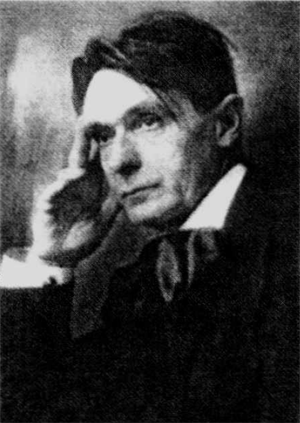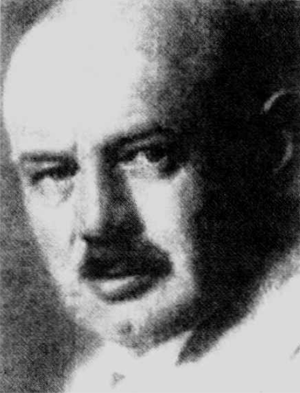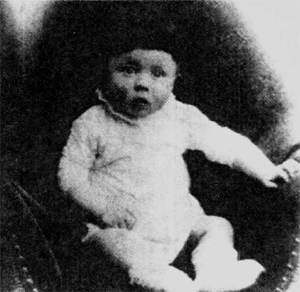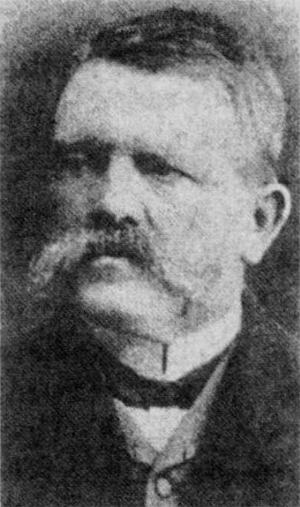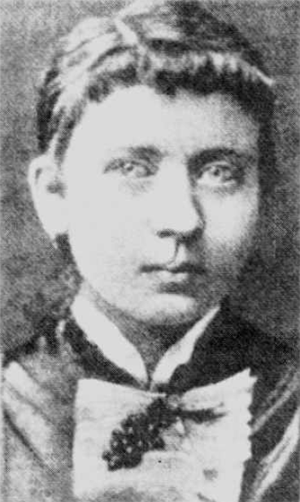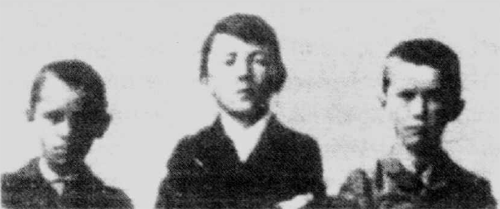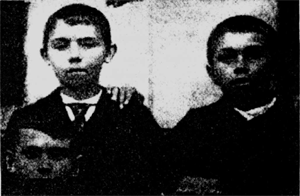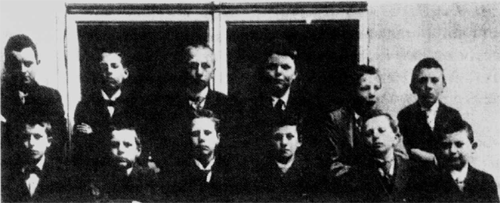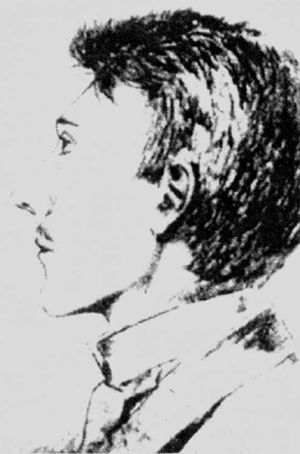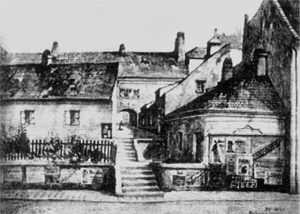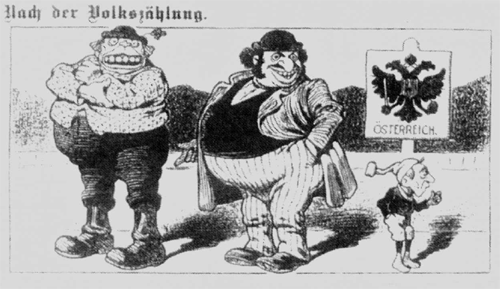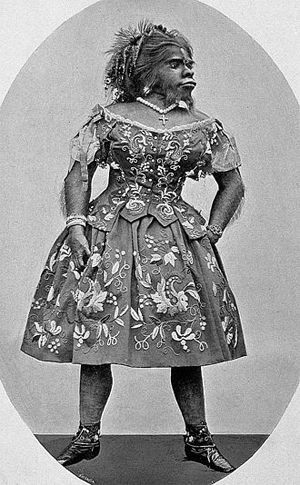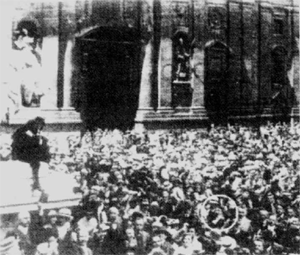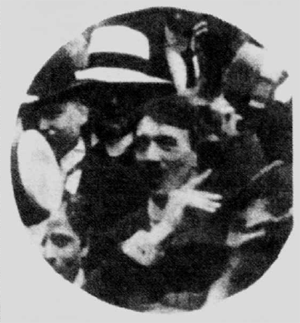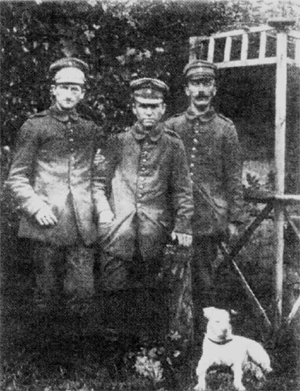12: The Anthroposophic Heresy
"Some people believe that the Threefold Social Order we are working toward would, ... split a horse into three parts ... We are not trying to divide the horse into three parts (of politics, economy, and culture); we simply want people to stop saying that a horse is real only when standing on one leg."
-- Rudolf Steiner
Occult Politics
Philosophy and religion always fascinated Dietrich Eckart. As a young man he read Arthur Schopenhauer's World As Will and Idea, Buddhist scriptures, and the mystical poetry of Angelus Silesius. He believed in God, and associated the Deity with "that Genius Higher than Human," the "Cosmic Intelligence" which enabled racially superior Aryans to see through Maya's Veil (Worldly Illusion.)
While in Berlin during the early 1900's Eckart associated with Theosophists. In 1906 he witnessed Rudolf Steiner lecturing from a dais that seemed "suspended in mid-air" through the artful use of mirrors. After reading Steiner's "Monism and Theosophy," and hearing him speak about Friedrich Nietszche, Eckart decided that he preferred Guido von List's German-centered Ariosophy to the "internationalism" of Anthroposophy. He and other volkisch militants denigrated anything cosmopolitan as "Jewish," therefore "un-German."
In 1914 Germany had three schools of occult thought: Theosophy, Ariosophy, and Anthroposophy. Members of the Theosophical Society adhered to Madame Helena P. Blavatsky's doctrines, as interpreted by Annie Besant and Charles Leadbeater. Ariosophists, such as Guido von List, and Adolf Josef Lanz von Liebenfals Jorg Lanz von Liebenfels, grafted Pan-German racism and anti-Semitism onto their own ersatz version of Theosophy. Anthroposophist Rudolf Steiner tried to "Christianize" Theosophy and subject it to scientific analysis. Deep divisions within the German Theosophical Society resulted in the secession of Steiner's Anthroposophists in 1913.
Between 1900 and 1906 Eckart moved around in the same Berlin Theosophical scene as Steiner. The two men shared an interest in the thought of Arthur Schopenhauer, Helena Blavatsky, and Friedrich Nietzsche -- though Eckart eventually soured on Nietzsche for being "a despiser of our religious foundations." [1] Their mutual acquaintances included occultists Theodore Reuss, Johannes Muller, Franz Hartmann, and Hugo Vollrath. These commonalities were outweighed by glaring differences. Steiner's universalism clashed with Eckart's racism. Anthroposophy valued Jewish sacred texts. Ariosophy rejected the entire Old Testament, agreeing with Madame Blavatsky's disapproval of its anthropomorphic deity,
" ... old reprobate Jehovah .. a cruel .. and jealous God with his sanguinary laws of eye for eye and tooth for tooth, of the shedding of blood and animal sacrifice ... " [2]
Believing Judaism a form of paganism Eckart contended in his poem "The Riddle" that
"The New Testament broke away from the Old ... As you once released yourself from the world. And as you freed yourself from your past delusions, So did Jesus Christ reject his Jewishness." [3]
In an August, 1921 Volkisch Beobachter article he wrote:
"Tear in pieces that lascivious bible of Satan, the Old Testament! ... Luther's translation of the Bible may have been of use to the German language; it irreparably injured the German people's power of judgment." [4]
Eckart accepted nebulous Eastern Theosophical notions about astral bodies attached to Oversoul, which itself connected to the Divine, via "Hierarchies." Thus, he believed that those who overcame materialism were more attuned to the Spiritual Realm.
"The Jewish conception of God is of no interest to us Germans! We seek God nowhere but within ourselves. For us the soul is Divine, of which the Jew knows nothing. 'The Kingdom of God is within you,' (Luke 17:21) thus God also, who belongs to the Kingdom of Heaven. We feel our soul is immortal, eternal from the beginning, and therefore ... refuse to be told we are created from nothingness." [5]
Ariosophists such as List and Lanz scorned Anthroposophy's notion of universal brotherhood, but it was not until Steiner announced his pacifism during World War I that Eckart turned violently against him.
Benign Mystic
The son of an Austrian railway official, Rudolf Steiner was born in Kraljevic, Croatia on February 25, 1861. At age eighteen he entered Technische Hochschule where he became the star pupil of renowned philologist Dr. Karl Julius Schroer. Upon graduation in 1883, he took philosophy courses from Franz Bretano and Robert Zimmermann at the University of Vienna. Steiner earned his Ph.D from the University of Rostock in 1891, after writing a dissertation on the Epistemology of Fichte's Philosophy of Science.
Through Karl Schroer's influence he received a fellowship to compile Goethe's collected scientific writings in Weimar. Steiner not only edited Goethe's scientific writings, but the complete works of Arthur Schopenhauer in twelve volumes and an eight volume collection of novelist Jean Paul's books. He also wrote scholarly essays, including scientific articles for Pierer's Encyclopedia on geology and mineralogy. Between 1899 and 1900 The Wilhelm Liebknecht Workers' Training School hired him to teach literature, science, and history.
While in Weimar Steiner frequented the Grienstidl Kaffee, a vegetarian restaurant where members of the Progressive Underground congregated.
Authoritarianism.
Fant’s statements about the character of anthroposophy are at odds with Rudolf Steiner’s precepts. In order to continue along the path of spiritual and racial advancement, Steiner taught, individuals must subordinate themselves to “the great leaders of humankind” (die großen Führer der Menschheit). If they fail to obey these leaders, their souls are condemned to spiritual and racial stagnation.[3] Anthroposophy is moreover based on an authoritarian epistemology which explicitly denigrates “criticism” and “judgement” while celebrating “reverent veneration” of ostensible spiritual virtues, and rejects “intellectual effort” in favor of “immediate spiritual perception.”[4] Contemporary anthroposophists’ uncritical attitude toward Steiner’s writings is further testament to this authoritarian framework. Fant is much too optimistic about the possibilities for “adapting Steiner’s texts to our time”; short of schism or apostasy, anthroposophy simply offers no grounds on which its adherents might coherently revise or refute its inherited doctrines. Furthermore, what Fant calls “the great, inspiring wholeness” of Steiner’s teachings depends entirely on anthroposophist credulity toward Steiner’s methods of occult revelation. Whatever the charms of this version of esotericism, such methods are irreconcilable with rational evaluation and independent confirmation.[5] In a judicious assessment of the anti-rational and authoritarian implications of the anthroposophic worldview, Sven Ove Hansson writes: “Steiner’s pronouncements are in practice never questioned in the anthroposophical movement, and very little of substance has been added to the doctrine after his death.”[6] An authoritarian disposition is unavoidable in a movement that considers itself to be preserving a “secret science” (Geheimwissenschaft), one of Steiner’s original terms for anthroposophy.[7]
Elitism.
Anthroposophy’s very nature as an esoteric worldview is predicated on the distinction between initiates and non-initiates, as well as on the notion of a ladder of knowledge which all initiates must climb step by step. These are the characteristic marks of an elitist mindset. Steiner also held that the German cultural elite, as the most spiritually advanced segment of the “Aryan race,” had a special mission to redeem the world from materialism. In his own words, “If one national civilization spreads more readily, and has greater spiritual fertility than another, then it is quite right that it should spread.”[8] His theory of the unique cultural mission of the German people was matched by an elitist social doctrine. In his economic writings, Steiner emphasized that all decisions must be made by “the most capable”; his “threefold society” was to be run not by the “hand-workers” but by “the spiritual workers, who direct production.”[9] And his racial theories, needless to say, were rigidly hierarchical and tied to anthroposophy’s elitist conception of spiritual progress: “Nations and races are merely the various stages of development toward pure humanity. A nation or a race stands higher the more perfectly its members express the pure, ideal human type, the more they have worked their way through from the transitory physical to the immortal supernatural. The development of humankind through reincarnation in ever higher national and racial forms is therefore a process of liberation.”[10] Even sympathetic observers note that Steiner’s anthroposophy aimed to create a “new spiritual elite”.[11]
Racism.
I do not doubt that many anthroposophists today are opposed to racist prejudice. But this admirable orientation does not justify their refusal to confront honestly their doctrine’s thoroughly racist origins. The entire edifice of anthroposophy is built on the comprehensive historical-evolutionary-racial typology Steiner laid out in Cosmic Memory and elsewhere. The key to this typology is the root-race doctrine, which divides the human family into five root races (Wurzelrassen, sometimes also named Hauptrassen or Grundrassen, principal or primary races), with two more root races to appear in the distant future. Each root race is further stratified into sub-races (Unterrassen), a term which eventually gave way, in Steiner’s writings, to the more recognizable unit of the people or nation (Volk). These categories are biological (Steiner calls them “hereditary”) as well as spiritual. The racial classifications are not normatively neutral; they are arranged in ascending order of spiritual development, with the fifth root race, the “Aryan race,” and within that root race the “Germanic-Nordic” peoples, at the top of the hierarchy. This hierarchy, according to Steiner, is an integral component of the cosmic order.
Steiner’s book Cosmic Memory remains to the present day the primary source for anthroposophy’s cosmology, with no distancing whatsoever toward its racist elements. The editor’s foreword to the current edition, published in Dornach, doesn’t so much as mention the book’s racist content, much less try to explain or minimize it; and the Anthroposophical Society continues to officially designate the book one of the “fundamental anthroposophist texts.”[12] Nor did Steiner himself ever renounce it; on the contrary, at the end of his life he called Cosmic Memory the “basis of anthroposophist cosmology.”[13] Today the book is still officially recommended for use by Waldorf teachers. Its racial mythology is elaborated in extravagant detail in many other works by Steiner published by anthroposophical presses.[14]
Thus according to both Steiner and his latter-day followers, humanity’s very existence is structured around the stratified scheme of higher and lower races.[15] Nor is it the case, as Fant would have us believe, that in Steiner’s view these racial divisions “will soon totally disappear.” Steiner taught that the “Aryan race” will reign until the year 7893, six thousand years in the future. Occasionally he indicated that the final transcendence of racial categories would happen sooner, in roughly 1500 years – still an extraordinarily long time to wait for anthroposophy to shed its racial obsessions. The Dutch anthroposophist commission on “anthroposophy and the race question,” on the other hand, reports that “according to Steiner, the word ‘race’ will no longer have meaning in 5,500 years.”[16]
It is also inaccurate and simplistic to say that Steiner gave the Aryan concept “quite another meaning than it later acquired in the Nazi era.” From the moment it was invented by European racial theorists in the nineteenth century, the preposterous notion of an “Aryan race” was inextricably bound up in the repugnant ideology of racial superiority. That Steiner himself shared this ideology is obvious from his contemptuous references to blacks, Asians, aboriginal peoples, Jews, and other non-“Aryans.” Steiner’s version of Aryanism was in fact strikingly similar, even in detail, to that of leading Nazi racial theorists. Steiner divided the Aryan root race into five sub-races: Ancient Indian, Persian, Egyptian-Chaldean, Greco-Roman, and Germanic-Nordic. By comparison, Nazi ideologist Alfred Rosenberg included the Indians, Persians, Greeks, Romans, Germans and Scandinavians in the “Aryan race.”[17] Similarly, Arthur de Gobineau’s version of the “Aryan race” comprised Indians, Egyptians, Persians, Greeks, Chinese, and Germans.[18] Richard Wagner held that the principal “Aryan” peoples were the Indians, Persians, Greeks, and Germans, and Houston Stewart Chamberlain’s conception of “the Aryans” was substantially similar to Steiner’s as well. Enthusiasts of anthroposophy would do well to familiarize themselves with the history of the Aryan myth.[19] Above all, they would do well to examine more closely the considerable continuities between Steiner’s description of the “Aryan race” and those put forward by the leading racists of the nineteenth century and their Nazi inheritors.[20]
In spite of all this evidence and context, Fant insists that “Steiner’s texts do not express any racism.” The only conclusions the rest of us can draw are that Fant has not read Steiner’s writings, or that he has a remarkably limited understanding of racism. The latter possibility is strongly suggested by Fant’s foolish example of “going out in the streets and slaughtering immigrants” as somehow typical of a racist mindset. He appears to believe that “well-meaning” people cannot be racist.[21] Fant has evidently never examined racism as a belief system or body of ideas. That these ideas continue to exert a powerful and pernicious influence in modern societies, without for the most part yielding directly murderous consequences, seems to have escaped his notice. Today’s naïve anthroposophists are the kinder, gentler counterpart to xenophobic thugs: not violent, not overtly discriminatory or prejudiced, indeed seemingly the opposite. That is why their potential role is so baleful: to make ‘soft’ racism and ‘soft’ nationalism socially acceptable in the heart of a materially comfortable but ideologically insecure middle class.
Anthroposophy’s politics.
Even if Fant’s claim that “anthroposophy is apolitical” were believable, it would hardly be reassuring; it is precisely this sort of naiveté toward the political implications of an all-encompassing quasi-religious worldview that is most worrisome about contemporary anthroposophists. Historically speaking, moreover, many of Steiner’s followers, including prominent and institutionally central anthroposophists, have been actively involved in fascist politics.[22] In any case, my article did not argue that all anthroposophists are enthusiastic activists of the radical right, but that the consistent connections between anthroposophic beliefs and far-right politics have been unmistakable since the doctrine first emerged a century ago. This persistent connection is a mainstay of current research on the European far right. In addition to the many sources cited in my article, interested readers may consult the following discussions of Steiner’s radical right followers: Jonathan Olsen, Nature and Nationalism; Volkmar Wölk, Natur und Mythos; Peter Kratz, Die Götter des New Age; Reinalter, Petri, and Kaufmann, Das Weltbild des Rechtsextremismus; Bernice Rosenthal, The Occult in Russian and Soviet Culture; Jahn and Wehling, Ökologie von rechts; Udo Sierck, Normalisierung von Rechts; Gugenberger and Schweidlenka, Die Fäden der Nornen: zur Macht der Mythen in politischen Bewegungen; Franz Wegener, Das atlantidische Weltbild: Nationalsozialismus und Neue Rechte auf der Suche nach der versunkenen Atlantis; Arn Strohmeyer, Von Hyperborea nach Auschwitz; Joscelyn Godwin, Arktos: The Polar Myth in Science, Symbolism, and Nazi Survival; Gugenberger, Petri, and Schweidlenka, Weltverschwörungstheorien: die neue Gefahr von rechts; Eduard Heller and Maegerle, Thule: Vom völkischen Okkultismus bis zur Neuen Rechten; Klaus Bellmund and Kaarel Siniveer, Kulte, Führer, Lichtgestalten: Esoterik als Mittel rechtsradikaler Propaganda; Harald Strohm, Die Gnosis und der Nationalsozialismus; Jutta Ditfurth, Entspannt in die Barbarei: Esoterik, (Öko-)Faschismus und Biozentrismus; Gerhard Kern and Lee Traynor, Die esoterische Verführung; Claudia Barth, Über alles in der Welt – Esoterik und Leitkultur; and Christiansen, Fromm, and Zinser, Brennpunkt Esoterik.[23] It is unacceptable to dismiss the virulent, widespread, and ongoing extreme right variant of anthroposophy as “some Germans from the thirties” and “a handful of ghosts of modern times.”[24]
Fant also tries to turn the recently deceased anthroposophist and right-wing extremist Werner Haverbeck into an enemy of anthroposophy, calling his adulatory biography of Steiner “a severe attack on anthroposophy” and a “total rejection of the anthroposophist movement.” This is a purely terminological argument; Fant presents no evidence for this nonsensical claim, but simply asserts that since Haverbeck’s views on anthroposophy differ from his own, Haverbeck must by definition be anti-anthroposophy. More telling still, Fant claims that Haverbeck’s portrait of Steiner as a committed German nationalist is “an absurd distortion.” Haverbeck’s book Rudolf Steiner – Anwalt für Deutschland is indeed politically and morally appalling, but its depiction of Steiner’s nationalism is entirely accurate, as the briefest familiarity with Steiner’s published writings plainly shows.
During his Vienna years, Steiner was an active member of the deutschnational or pan-German movement in Austria. In the last two decades of the nineteenth century he wrote dozens of articles for the German nationalist press, which are reprinted in volumes 29, 30, 31 and 32 of his Collected Works (above all Gesammelte Aufsätze zur Kultur- und Zeitgeschichte and Gesammelte Aufsätze zur Literatur).[25] These pan-German publications are politically unambiguous, and they make a mockery of Fant’s naive assertion that nationalism always “bothered Steiner.”[26] Steiner’s German cultural nationalism, based on a chauvinist conviction of superiority and a sense of national mission as well as simple ethnic prejudice, became frantic with the onset of World War One, as his blustery wartime lectures testify (collected in Zeitgeschichtliche Betrachtungen and Die geistigen Hintergründe des Ersten Weltkrieges and elsewhere); and he re-affirmed his German nationalist line in his post-war lectures as well (see, for example, Bewußtseins-Notwendigkeiten für Gegenwart und Zukunft). Steiner remained unapologetic about his nationalist engagement to the end of his life, recalling his pan-German activism in his 1925 autobiography. It may be an uncomfortable fact for progressive anthroposophists to acknowledge, but the far-right Haverbeck had a much more accurate understanding of Steiner on this question than the liberal Fant.
In the period since my original exchange with Fant, anthroposophy’s politics have not, alas, been clarified. The far-right inflection of Steiner’s teachings continues to gain adherents and publicity.[27] The case of Andreas Molau is particularly instructive in this regard. In the 1990s Molau was a prominent publicist on Germany's far-right fringe, and after 2000 became active in the NDP, the major neo-Nazi party in Germany today. Molau also worked as a history teacher at a Waldorf school in the city of Braunschweig for eight years. He was fired (or, by some accounts, resigned) in 2004 when Molau’s official position in the NPD became public.[28] The chief concern for the administration of Molau's Waldorf school was the possible impact of Molau's party work on the school's reputation; as the school's principal told the media at the time: “This is a catastrophe for our image.” Molau’s Waldorf colleagues, meanwhile, claimed to have been unaware of his political involvements.[29] Assuming this claim is true, it raises the obvious question of just how Molau's fellow Waldorf teachers and staff managed not to know about his far-right affiliations for so long. Molau taught history and German (not, for example, math or music) at the same Waldorf school for eight years, and even after the NPD episode erupted into a public scandal, his Waldorf colleagues said they had viewed him as “left-liberal” and “a sympathetic oddball”; they were unanimously surprised to learn of his far-right political activities. But Molau had been a prominent figure on the radical right for a very long time, since the beginning of the 1990s, writing for a range of far-right publications under his real name; for several years he was even culture editor of Junge Freiheit, one of the most notorious of Germany's extreme right wing journals (where among other things he published an article denying the holocaust).[30] Molau’s openly apologetic biography of Nazi ideologue Alfred Rosenberg was published in 1993.[31] Molau was moreover mentioned in readily available sources on the far right, such as the Handbuch deutscher Rechtsextremismus (handbook on German right-wing extremism) published in 1996. Yet none of Molau’s fellow Waldorf faculty, staff, or parents was aware of any of this information whatsoever. The incident speaks volumes about the level of political obliviousness that is apparently endemic at Waldorf schools today.
Even after leaving Waldorf employment, Molau continues to support Waldorf education strongly. In the immediate aftermath of his departure from the Braunschweig Waldorf school, he forcefully re-affirmed his ongoing esteem for Steiner and his own unchanged commitment to Waldorf pedagogy. He has since run in several campaigns as one of the NPD’s better-known politicians, and his election materials consistently highlight his experience as a Waldorf teacher. Within the NPD executive, Molau is responsible for educational policy. In 2005, as an NPD candidate, Molau was invited to speak at a Waldorf school in Berlin, where he quoted from Steiner’s book on the Mission of the Folk Souls, and declared that Waldorf pupils are “the ideal target audience for the NPD, because of Waldorf schools’ natural feeling for living authority and their cultivated inner connection with German culture.” The NPD put out a press release celebrating this Waldorf event as a breakthrough with youth. In 2007, Molau announced his plan to open a Waldorf educational center under NPD auspices. With this new Waldorf project, the neo-Nazi politician hopes to show “the connection between the nationalist NPD ideology and the teachings of the founder of anthroposophy, Rudolf Steiner.”
Fant presumably still believes that such incidents – repeated over and over again in the world of Waldorf, biodynamics, and anthroposophy – are merely isolated, marginal, insignificant anomalies that tell us nothing important about the ostensibly “apolitical” nature of anthroposophy. This is nothing but a pretense, and serves quite simply to protect and promote the ongoing infiltration of the far right within the anthroposophical milieu. The Molau case was not a fluke. In late 2004, in the wake of the controversy over Molau's Waldorf career, the editor of the anthroposophical journal Info3 reported that “a whole array of private voices” within German anthroposophical circles had spoken up in support of Molau. In November 2004, a leading far-right newspaper, the National-Zeitung, published a very sympathetic interview with Molau conducted by an even more famous right-wing extremist, Gerhard Frey.[32] Here Molau emphasized the conceptual affinities between anthroposophy and the contemporary German far right, while citing Steiner’s book The Philosophy of Freedom and touting the wonders of Waldorf education. Molau also noted the support and solidarity he had received from like-minded associates within the Waldorf movement. Molau’s parting of ways with the Braunschweig Waldorf school, in other words, has scarcely solved the problem.[33] Such incidents will continue to recur until anthroposophists finally face their far-right affiliations head-on.
-- The Art of Avoiding History, by Peter Staudenmaier
Karl Schroer introduced him to such leading Viennese Theosophists as Friedrich Eckstein (Franz Hartmann's patron,) Marie Lang, Edmund Lang, and Rosa Mayreder. Steiner also socialized with Nietszche's circle -- including Alfred Schuler, another acquaintance of Eckart. He boarded with Frau Anna Eunicke, the widow of an intellectual recluse, and her daughters. Although Anna was several years older than himself, Steiner married her in 1897. That year he moved the family to Berlin, after receiving an offer to edit The Magazine for Literature.
At the behest of Count Ulrich von Brockdorff-Rantzau, Steiner gave a series of lectures at the Berlin Theosophical Society in 1900. His Anthroposophical ideas took shape in July, 1901 after meeting Social Darwinist Ernst Haeckl at the London Theosophical Society conference. In October, 1902 Steiner addressed the Giordano Bruno Society on "Monism and Philosophy." He called for the unification of science and religion, proclaiming that "de-spiritualization" had gone full circle. Atheism and mechanistic science were both outmoded. Modern science would benefit from an infusion of spirituality, just as dogmatic religion desperately needed to reconcile itself to science. Dietrich Eckart concurred with the mystical Christian currents in Steiner's thought, which held that men must renounce materialism. "De-spiritualization" was one of his favorite jargon terms. Eckart also embraced his concept that every nation had a Folk-Soul -- and Germany's was the most highly-evolved.
Steiner met an attractive Baltic German actress and dancer named Marie von Sievers (1867-1948) in 1902. She recruited a bevy of Russian exiles into his circle, and arranged speaking tours for him. Romance soon blossomed between magus and votary. The overwhelming "karmic connection" between himself and Marie took precedence over his marriage to Anna, from whom he separated in 1903.
Steiner attracted a following with his campaign of unifying science and spirituality. German spiritualists elected him General Secretary of The Theosophical Society in 1902. Steiner accepted on condition that he have freedom to develop his own spiritual ideas, and not be compelled to defend all tenets issuing from the Society's International Branch in Madras, India. His tenure proved controversial. He advocated Rosicrucianism, a Christian form of occultism. The conversions of Theosophists Helena Blavatsky and Henry Olcott to Buddhism offended him, as did other aspects of their theology. They preferred the impersonal Brahman concept of Atma to the Monotheistic God of Israel. Madame Blavatsky associated the Holy Spirit with Lucifer, the Light Bearer. Steiner deplored this attempt to whitewash the devil as a Promethean hero. He believed that demonic spirits had infected the Theosophical movement with paganism, and resolved to reform spiritualism along Christian lines.
Everything that is connected with propagation and with heredity, everything that is independent of man in the sense that he cannot penetrate it with his thinking, everything that is the gift of the Moon in the celestial firmament—that, in man, is what has proceeded from the principle of Love permeating the process of propagation and heredity. Hence the violent battle which persists through history, the battle waged by Lucifer and Ahriman against everything that comes from this domain. Lucifer and Ahriman want to force on man the exclusive sovereignty of the head, and they launch their attacks by way of the head against everything that is purely natural affinity. For whatever is hereditary substance on the Earth cannot be wrested away by them. What the Moon is in the heavens, heredity is in men on the Earth below. Everything that is grounded in heredity, everything that is not charged with thought, that is connected intrinsically with physical nature — that is the Jahve-principle. The Jahve-principle unfolds its greatest activity where nature is working as nature; it is there that Jahve has outpoured in greatest measure the Love that is his natural attribute, in order to create a counterweight to the lovelessness, the mere wisdom, of Lucifer and Ahriman.
-- The Occult Movement in the Nineteenth Century and Its Relation to Modern Culture, by Rudolf Steiner

